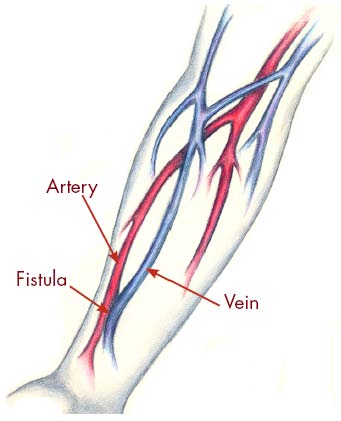Vascular Access

Vascular access, is a way to reach the blood for hemodialysis. The access allows blood to travel through soft tubes to the dialysis machine where it is cleaned as it passes through a special filter, called a dialyzer. An access is placed by a minor surgery. As a hemodialysis patient, your access is one of the following:
A fistula:
An access made by joining an artery and vein in your arm.
A graft:
An access made by using a piece of soft tube to join an artery and vein in your arm.
A catheter:
A soft tube that is placed in a large vein, usually in your neck.
Only a few sites on the body are suitable for vascular access. It is therefore important for patients to care for their access to ensure it lasts for as long as possible.
It is essential that you take good care of your vascular access site:
Avoid wearing clothes with tight fitting sleeves.
Avoid wearing watches or jewellery on their access arm.
Do not carry heavy bags with your access arm.
Do not sleep on your access arm.
Never take blood samples from the access arm and never inject into it unless it is with a fistula needle
when having a dialysis session.
Do not have blood pressure readings taken on their arm with their functioning dialysis access.
If you have had a fistula created in your arm, some simple exercises can help to encourage it to heal more quickly.
You should make sure that you carry out any exercises that are given.
It is essential to make sure that your vascular access is clean.
The access site should be cleaned thoroughly before use, and anyone who will be handling your access should wash their hands and put on sterile gloves first.
You must make sure to check your access site for signs of infection or damage every day.
These include:
• Redness
• Swelling
• Pain
• Numbness
• Warmth
• Fever
• Pus or open sores
It is important that the dialysis unit checks your vascular access site for signs of blockage at every session. They can listen to the sound of the blood flow through it (the ‘bruit’) using a stethoscope and feel for the vibration using their fingers.
It is essential that they report any changes they see or feel in your access site to your nephrologist or surgeon immediately. Make sure they know who to contact.


